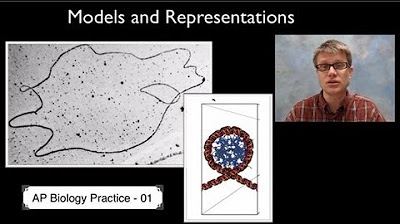AP Biology Practice 5 - Analyze Data and Evaluate Evidence
Summary
TLDRThis AP Biology practice video by Mr. Andersen focuses on analyzing and evaluating scientific data. It emphasizes the importance of recognizing patterns, outliers, and extraneous data, and uses Charles Keeling's atmospheric carbon dioxide data as an example. The video also covers how to interpret data in various biological contexts, including evolution, free energy, information processing, and systems. It concludes by highlighting the value of data in understanding complex phenomena, such as NASA's visualization of ocean currents.
Takeaways
- 📊 The importance of data analysis in science is emphasized, with a focus on identifying patterns, outliers, and extraneous data.
- 🌿 Charles David Keeling's work on atmospheric carbon dioxide levels at Mauna Loa, Hawaii, is highlighted as an example of significant data collection.
- 📈 Organizing data through graphs is a crucial step in making sense of overwhelming amounts of data and identifying trends.
- 🌡 The script discusses the impact of annual cycles on carbon dioxide levels, influenced by the sun's movement and plant growth.
- 🧪 The relationship between fertilizer amount and plant growth is presented as an example of how data visualization can reveal relationships and potential outcomes.
- 🔍 The need to control for variables and ask the right questions when analyzing data is stressed to ensure meaningful conclusions.
- 🌐 The script touches on the 'big ideas' in biology that the College Board may test, including evolution, free energy, information, and systems.
- 🔬 Examples of how to analyze data in the context of these big ideas are provided, such as the sucrose lab for free energy and signal transduction in information.
- 📝 The ability to write short essays explaining biological factors that determine graph shapes, like predator-prey relationships, is a skill that may be assessed.
- 🔍 Identifying possible sources of error in a dataset and understanding how to revise protocols for more valid data is an important aspect of scientific inquiry.
- ❓ Multiple choice questions and the ability to interpret genetic data, such as understanding epistasis in flower color inheritance, are part of evaluating data analysis skills.
Q & A
What is the primary focus of AP Biology Science Practice 5?
-The primary focus of AP Biology Science Practice 5 is analyzing data and evaluating evidence, particularly looking at how to determine if the data collected is good or bad, identifying patterns, and understanding the implications of the data for the research question.
Why is organizing data important when analyzing it?
-Organizing data is crucial because it helps to identify patterns, outliers, and trends that might not be apparent when looking at raw data. Visualization tools like graphs are especially useful in making sense of large data sets.
What was the significance of Charles David Keeling's data collection?
-Charles David Keeling collected significant data on atmospheric carbon dioxide at Mauna Loa, Hawaii. His data revealed an increase in CO2 levels over time, which is closely linked to global warming and the greenhouse effect.
How can annual cycling affect atmospheric carbon dioxide levels?
-Annual cycling affects atmospheric carbon dioxide levels due to the varying amounts of plant growth as the sun moves between the northern and southern hemispheres. This results in different levels of CO2 being absorbed and released.
What is a potential outcome of increasing fertilizer amounts on plant growth?
-Increasing fertilizer amounts generally leads to an increase in plant growth, as visualized by a curve on a graph plotting fertilizer amount against plant growth. However, there may be a point of diminishing returns or negative effects if fertilizer is overused.
How might the College Board test your ability to analyze data?
-The College Board might test your ability to analyze data by asking you to identify patterns, understand relationships like predator-prey dynamics, or recognize potential sources of error in experiments such as the potato cores in different sucrose solutions.
What are biotic factors, and how might they influence a predator-prey relationship?
-Biotic factors include elements like food supply, space, competition with other organisms, and interactions between predator and prey. These factors influence predator-prey dynamics by affecting population sizes and the overall stability of the ecosystem.
What could be a potential source of error in the potato cores experiment?
-A potential source of error in the potato cores experiment could be mislabeled beakers, leading to incorrect molarity readings and unexpected changes in mass that do not align with the expected outcomes.
What is epistasis, and how does it relate to the genetics question in the script?
-Epistasis is a genetic phenomenon where one gene affects the expression of another gene, influencing traits like flower color. In the genetics question discussed in the script, epistasis accounts for the unexpected ratio of flower colors observed.
How does NASA use data visualization to aid in understanding complex data sets?
-NASA uses data visualization to help make sense of complex data sets, such as ocean currents, by creating animations like 'Perpetual Ocean.' These visualizations make it easier to identify patterns and learn from the data, even when it is vast and intricate.
Outlines

此内容仅限付费用户访问。 请升级后访问。
立即升级Mindmap

此内容仅限付费用户访问。 请升级后访问。
立即升级Keywords

此内容仅限付费用户访问。 请升级后访问。
立即升级Highlights

此内容仅限付费用户访问。 请升级后访问。
立即升级Transcripts

此内容仅限付费用户访问。 请升级后访问。
立即升级浏览更多相关视频

AP Biology Science Practice 1: Models and Representations

AP Biology Practice 7 - Connecting Knowledge

AP Biology Practice 3 - Formulate Questions

AP Biology Practice 2 - Using Mathematics Appropriately

AP Biology Practice 6 - Scientific Explanations and Theories

AP Biology Practice 4 - Data Collection Strategies
5.0 / 5 (0 votes)
